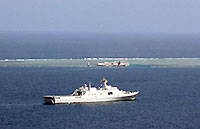Myanmar ceasefires aid search for WWII dead
By Junichi Fukasawa (asianewsnet) Updated: 2013-01-03 11:00Ceasefires with armed groups linked to ethnic minorities in Myanmar might enable searches in previously inaccessible areas for remains of Japanese killed during World War II.
The search for sites where remains could be found in regions controlled by 14 armed groups is set to begin early this month.
The recent ceasefires between the central government and minority groups as part of democratisation in Myanmar represent major breakthroughs, as some areas have seen more than 60 years of near-constant conflict. The fighting has hindered the search for Japanese war dead.
A large number of Japanese soldiers were killed in Myanmar during World War II in the Battle of Imphal and other fighting, and the remains of more than 45,000 Japanese military and civilian personnel are believed to have been left behind.
Collecting remains could begin after the Health, Labour and Welfare Ministry obtains relevant information, government officials said.
The investigations will be carried out by the Thai-Japan Education Development Foundation (TJEDF), the United Nationalities Federal Council (UNFC)--a federation of 11 armed groups in Myanmar--and three other armed groups.
TJEDF, based in Chiangmai, northern Thailand, has since last year been providing agricultural and educational support for people living in areas controlled by the armed groups.
In mid-December, TJEDF and UNFC signed a memorandum agreeing to cooperate in trying to find information that might eventually lead to searches for Japanese war dead. A Japanese group will provide financial and other backing for the effort.
Each of the 14 armed groups will form full-time investigation teams of two or more people each to survey local villages for information from early January to November.
Data will be gathered on a variety of topics that could aid in discovering remains and other personal effects, including what happened in the battles, how people died, and whether bodies were buried or interred in pagodas.
The information is to be compiled into a report to be submitted to the ministry in December.
During World War II, about 137,000 Japanese military and civilian personnel died at the front in Burma [now Myanmar]. Since 1956, more than 10 searches for Japanese war dead have been conducted in government-controlled regions, which found and collected the remains of more than 20,000 people.
The remains of about 90,000 people have been collected, including those brought back to Japan by members of the defunct Imperial Japanese Army and others. However, new finds have levelled off in recent years.
"We welcome the development since we believe it will help bring more people's remains back to Japan," an official at the ministry's Social Welfare and War Victims' Relief Bureau said. "If we can obtain accurate information, we'd like to dispatch a government group to collect the remains."
The government began searching for remains of Japanese citizens--mainly soldiers and civilian workers for the Imperial Japanese Army--who died during World War II outside the mainland in fiscal 1952.
According to the ministry, of about 2.4 million war dead whose remains government-led projects have searched for, about 330,000 have been found and returned home.
The remains of 1.27 million people, including those brought back to Japan by members of the then Imperial Japanese Army and others, had been found as of the end of March 2012, leaving about 1.13 million that have yet to be returned to Japan.







